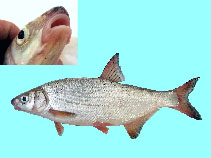Uploaden van uw Foto's en video's
Pictures | Google afbeeldingVimba vimba
Picture by Otel, V.
Pictures | Google afbeeldingVimba vimba
Picture by Otel, V.
Ukraine country information
Common names:
Rybets, Syrt, Рибець
Occurrence: native
Salinity: freshwater
Abundance: | Ref:
Importance: | Ref:
Aquaculture: | Ref:
Regulations: | Ref:
Uses: no uses
Comments: Extirpated in Crimea (Ref. 59043). Also Ref. 683.
National Checklist:
Country Information: https://www.cia.gov/library/publications/resources/the-world-factbook/geos/up.html
National Fisheries Authority:
Occurrences: Occurrences Point map
Main Ref: Kottelat, M. and J. Freyhof, 2007
National Database:
Occurrence: native
Salinity: freshwater
Abundance: | Ref:
Importance: | Ref:
Aquaculture: | Ref:
Regulations: | Ref:
Uses: no uses
Comments: Extirpated in Crimea (Ref. 59043). Also Ref. 683.
National Checklist:
Country Information: https://www.cia.gov/library/publications/resources/the-world-factbook/geos/up.html
National Fisheries Authority:
Occurrences: Occurrences Point map
Main Ref: Kottelat, M. and J. Freyhof, 2007
National Database:
Common names from other countries
Classificatie / Names Lokale namen | Synoniemen | Catalog of Fishes(Genus, Soort(en)) | ITIS | CoL | WoRMS | Cloffa
Environment: milieu / climate zone / depth range / distribution range Ecologie
; zoet water; brak water benthopelagisch; anadroom (Ref. 51243). Subtropical; 10°C - 20°C (Ref. 2059); 64°N - 35°N, 12°E - 53°E
Verspreiding Landen | FAO regio's | Ecosystemen | Voorkomen | Point map | Introducties | Faunafri
Eurasia: Caspian, Black, Marmara and Baltic Sea basins (Sweden and Finland north to 63°N), North Sea basin from Elbe to Ems drainages. In Anatolia: in Marmara basin, south to Great Menderes and Lake Egridir and east to Kızılırmak drainage. Absent between Kızılırmak and Çoruh drainages. Extirpated in Crimea. Introduced in Rhine.
Grootte / Gewicht / Leeftijd
Maturity: Lm ? range ? - ? cm
Max length : 50.0 cm TL mannelijk / geslacht onbekend; (Ref. 556); common length : 20.0 cm TL mannelijk / geslacht onbekend; (Ref. 556); max. gepubliceerd gewicht: 1.4 kg (Ref. 35541); max. gerapporteerde leeftijd: 15 Jaren (Ref. 59043)
Max length : 50.0 cm TL mannelijk / geslacht onbekend; (Ref. 556); common length : 20.0 cm TL mannelijk / geslacht onbekend; (Ref. 556); max. gepubliceerd gewicht: 1.4 kg (Ref. 35541); max. gerapporteerde leeftijd: 15 Jaren (Ref. 59043)
Korte beschrijving Determinatiesleutels | Morfologie | Morfometrie
Dorsale stekels (totaal) : 3; Dorsale zachte stralen (totaal) : 8 - 9; Anale stekels: 3; Anale zachte stralen: 16 - 22. Diagnosed from its congeners in Europe by the following characters: anal fin with 16-21½ branched rays; back keeled behind dorsal base; in spawning season, males blackish brown with orange cheek and sometimes belly (Ref. 59043). Caudal fin with 19 soft rays. Scalar formula: 49-64, 6-10 (Ref. 40476).
Inhabits brackish estuaries, large to medium rivers and some large subalpine lakes. Sedentary populations inhabit even in small rivers or barbel zone. Feeds mainly on small molluscs and insect larvae. Breeds in riffles in shallow, fast-flowing streams and rivers on gravel. Semi-anadromous populations forage in freshened parts of sea and migrate for long distances to spawn. Lacustrine populations move to fast-flowing tributaries. Spent adults return to foraging habitats (Ref. 59043). Threatened from its range due to water obstruction (Ref. 26100).
Levenscyclus en paargedrag Maturiteit | Voortplanting | Paaien | Eieren | Fecunditeit | Larven
Produces 15,000-20,000 eggs at the age of 6-7 years (Ref. 12259). Spawns for several years. Semi-anadromous populations undertake long distance spawning migrations while lacustrine populations migrate to fast-flowing tributaries. In Dniepr and Kuban, migration starts in September, decreases in winter and resumes in March-May (Ref. 59043).
Hoofdreferentie
Upload your references | Referenties | Coördinator | Medewerkers
Kottelat, M. and J. Freyhof, 2007. Handbook of European freshwater fishes. Publications Kottelat, Cornol and Freyhof, Berlin. 646 pp. (Ref. 59043)
Status op de Rode Lijst van het IUCN (Ref. 130435: Version 2024-2)
Niet bedreigd (LC) ; Date assessed: 18 July 2022
Gevaar voor de mens
Harmless
Gebruik door de mens
Visserij: van minder commercieel belang; Aquacultuur: commercieel; sportvis: ja
FAO(visserij: productie; publication : search) | FishSource |
Meer informatie
Population dynamics
Groeiparameters
Max. ages / sizes
Length-weight rel.
Length-length rel.
Lengtefrequenties
Massaconversie
Rekrutering
Abundantie
Groeiparameters
Max. ages / sizes
Length-weight rel.
Length-length rel.
Lengtefrequenties
Massaconversie
Rekrutering
Abundantie
Life cycle
Voortplanting
Maturiteit
Fecunditeit
Paaien
Spawning aggregations
Eieren
Ontwikkeling van de eieren
Larven
Larvale populatiedynamiek
Voortplanting
Maturiteit
Fecunditeit
Paaien
Spawning aggregations
Eieren
Ontwikkeling van de eieren
Larven
Larvale populatiedynamiek
Anatomy
Kieuwoppervlak
Brain
Otolith
Kieuwoppervlak
Brain
Otolith
Physiology
Body composition
Nutrients
Zuurstofverbruik
Zwemtype
Zwemsnelheid
Visual pigments
Fish sound
Diseases & Parasites
Toxicity (LC50s)
Body composition
Nutrients
Zuurstofverbruik
Zwemtype
Zwemsnelheid
Visual pigments
Fish sound
Diseases & Parasites
Toxicity (LC50s)
Human related
Aquaculture systems
Aquacultuurprofielen
Kweeklijnen
Ciguatera cases
Stamps, coins, misc.
Aquaculture systems
Aquacultuurprofielen
Kweeklijnen
Ciguatera cases
Stamps, coins, misc.
Tools
Bio-Quiz | E-boek | Veldgids | Lengtefrequentie Tool | Levenscyclus tool | Verspreidingskaart | Classification Tree
| Catch-MSY |
Speciale rapporten
Bekijk gegevens voor het houden in een aquarium | Bekijk Fact Sheets voor de soort | Bekijk Aquacultuur Fact Sheets
Download XML
Internetbronnen
Exoten/Invasieve soorten database | Aquatic Commons | BHL | Cloffa | Websites from users | Bekijk FishWatcher | CISTI | Catalog of Fishes(Genus, Soort(en)) | DiscoverLife | ECOTOX | Faunafri | Fishtrace | GenBank(genoom, nucleotide) | GloBI | GOBASE | | Google Books | Google Scholar | Google | IGFA World Record | MitoFish | Nationale databanken | Otolith Atlas of Taiwan Fishes | Publieke aquaria | PubMed | Reef Life Survey | Scirus | SeaLifeBase | Tree of Life | Wikipedia(ga naar, zoek) | World Records Freshwater Fishing | Zoological Record
Estimates based on models
Fylogenetische diversiteitsindex (Ref. 82804): PD50 = 0.5625 [Uniqueness, from 0.5 = low to 2.0 = high].
Bayesian length-weight: a=0.00724 (0.00659 - 0.00796), b=3.14 (3.11 - 3.17), in cm Total Length, based on LWR estimates for this species (Ref. 93245).
Trofisch niveau (Ref. 69278): 3.3 ±0.1 se; based on diet studies.
Weerstandsvermogen (Ref. 120179): laag, minimale populatieverdubbelingstijd 4,5-14 jaar (K=0.22; tm=3; tmax=15).
Fishing Vulnerability (Ref. 59153): Moderate vulnerability (37 of 100).




